How to Plan Delivery to Grow Your Business in 2025
Learn how to plan deliveries in 2025. Discover what is delivery planning, its most effective elements, what tools to use, and the latest success...
Home > Blog > Route Planning Strategy: 100 Deliveries Per Month vs 10,000 Per Day
Delivery LogisticsIs there a difference between planning routes for 100 deliveries per month vs. 10,000 deliveries per day? ABSOLUTELY. And here we break down the strategy.
We have a simple strategy to plan routes for 10,000 deliveries per day.
That’s right:
You can get 10,000 delivery orders done each day!
It’s so effective that you can use this same strategy to plan routes whatever your daily, weekly, or monthly delivery volumes may be.
THE SECRET: Route Planning Software.
(And that’s a whole lot different from using manual planning, fixed routes, Google Maps, or spreadsheets to plan 5 deliveries per day.)
In this post, we break down the best strategy to scale your route planning from 10 to 10,000 deliveries per day.
Let’s get started.
Before you start planning thousands of routes each day, let’s take a look at how you should do it when you’re just starting off.
When you have barely any deliveries.
And when you have to plan routes for a few hundred orders per month. (Not per day.)
First things first:
You have to start planning delivery routes.
Even when you have just a few deliveries per day, you can’t skip this step.
Why?
Planning routes for deliveries helps you to stay efficient.
On the one hand, it raises delivery speed and minimizes fuel consumption.
On the other hand, it promotes discipline among drivers and boosts their performance.
So once you grow and scale, you already have a culture that’s based on efficiency.
Which means lower costs, higher order volumes, and greater profit margins.
So how do you do it when you’re just starting out?
While Google Maps isn’t a true route planning app, it’s a great tool when you’re just starting off.
Google Maps makes it easy to find the most direct route from point A to point B.
The app also generates up to three different routes for you to choose from:
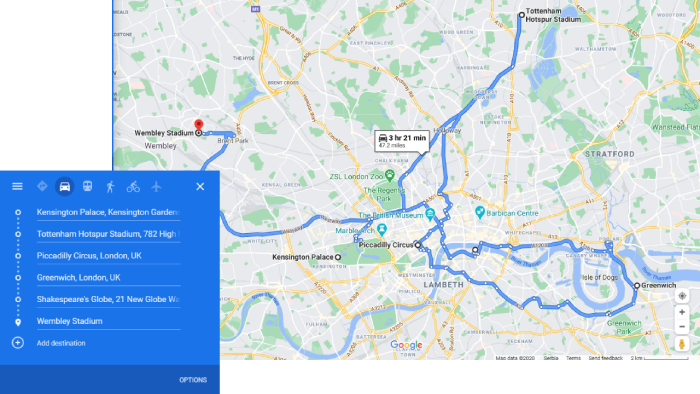
So you can select the fastest route or the one with the least amount of traffic:

Plus, you can use it to plan routes with up to 10 stops.
And it’s FREE. So using it doesn’t cost you a thing.
But it does cut costs even when you have to fulfill just a few orders per day.
The next good practice is to use spreadsheets to organize your orders.
This makes it easier to schedule deliveries and keep track of order volumes, in general.
You can do this with Microsoft Excel or with Google Spreadsheets.
(Another completely free tool by Google.)
At the very basic level all you need to include is:
That isn’t much different from the template that our larger clients use:

But it will be helpful down the line, once you start generating their numbers.
You should also make use of creating fixed routes.
Basically:
Fixed delivery routes are the most efficient way to fulfill orders to recurring customers or delivery zones.
That doesn’t mean it’s the fastest way to deliver goods.
And it doesn’t work with next-day or same-day delivery that good.
But if you handle a lot of B2B deliveries, you can plan and schedule deliveries ahead of time for across different dates.
Or handle multiple delivery zones across multiple dates. For example, in five different cities.
Which does cut costs, especially when you’re just starting off.
But…
NOTHING.
All of the strategies that we’ve outlined work really well together.
In fact, these tactics make it easier and quicker to plan routes.
And boost efficiency and the speed of your delivery.
BUT to a certain extent.
That’s why they only work when you have a small fleet that handles low delivery volumes.
And that becomes apparent when you start growing your operations.
Think of it like this:
When you’re just starting out, you can probably handle all of your deliveries with a single driver.
But as you receive more delivery requests that one driver won’t be able to handle the entire workload.
So what do you do?
You hire another driver. And then another. And another…
Pretty soon you’ll have to hire a dispatcher. And a dedicated delivery manager. And so on.
The point is as your delivery volume increases, so do your operations.
And once that starts happening, you need to change your delivery planning process.
Including how you plan delivery routes.
And that’s why those simple route planning strategies only work for small businesses.
So…
A route planning threshold is the minimum number of deliveries that an organization handles per day or per month at which point it isn’t practical anymore to manually plan routes to fulfill all orders.
This number isn’t tied to the amount of vehicles or drivers that you have, because expanding your fleet doesn’t affect efficiency.
It only raises the costs and complexity of your delivery operations and processes.
And that isn’t the purpose of strategic delivery planning in the first place.
So simply put:
The route planning threshold tells you when it’s time to STOP manual planning and START automating the route planning process.
This is a completely new concept.
And it has helped us to determine whether or not companies actually need to double down on route planning software.
Or if they still have room to grow before investing in delivery automation.
Of course, this isn’t an exact measurement.
And the threshold changes from company to company. And from industry to industry.
But based on 1000+ inquiries and use cases we have determined an approximate number when businesses should consider start automating:
Companies that have to complete more than 50 deliveries per day or 1000 deliveries per month should start using software to plan their delivery routes.
This can lead to a significant efficiency boost that can lead to $1,126.67 monthly savings per vehicle.
But that doesn’t mean that the tactics we’ve outlined become obsolete.
In fact, they’re integrated (in one way or another) into the route planning software.
While adopting these advanced strategies works exceptionally well even when you have to plan routes for 10,000 deliveries per day. (And beyond!)
Which means you can use them at scale, at any point as you grow.
And maintain the highest level of efficiency at every stage of that journey.
So what are these advanced strategies?
Let’s take a look:
Route planning 10,000 deliveries daily is all about automation.
You’ll still plan routes.
You can still use Google Maps and even spreadsheets.
But not in the way you might think.
Instead, you’ll be using route optimization software for all of that.
And much, much more.
And it’s all going to be automated.
So let’s see how you can plan routes for 10,000 deliveries per day using routing software.
Here’s our step-by-step guide:
First things first:
You need to choose and invest in route optimization software.
And there are a lot of options currently on the market.
You may not want to choose eLogii, but we compare well against most other solutions out there.
This includes Bringg, Onfleet, Routific, Tookan, Workwave, and many others:
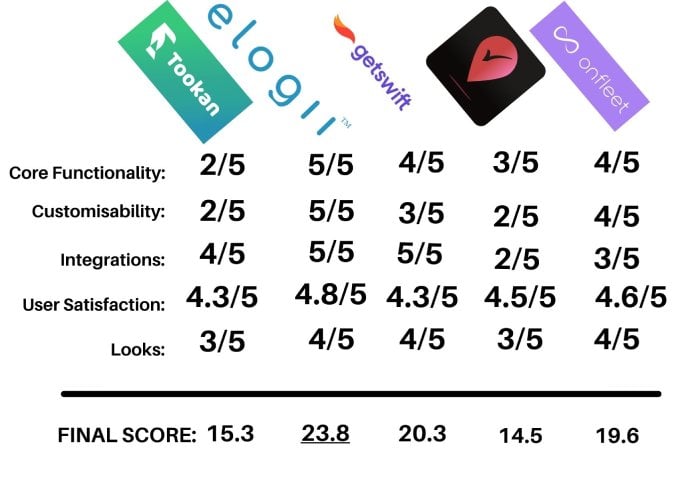
But not all of them perform in the same way.
Especially when it comes to planning such large delivery volumes.
To get the best routing software, you should focus on:
1. Software Capabilities
Software capabilities encompass a wide range of different features that you get access to from a specific provider.
For example, eLogii has a total of 97 features. These cover everything from route optimization to proof of delivery (POD) and customer experience.
When it comes route planning, you’ll want a solution that allows you to:
For more information about all of our software capabilities, please BOOK A DEMO. And one of our team members will walk you through all of them based on real-world examples.
2. Plans & Payment
Different software providers offer different plans and features based on the size and complexity of your operations.
Most offer three-tier plans: Starter (for SMBs), Premium and Professional (for enterprises).
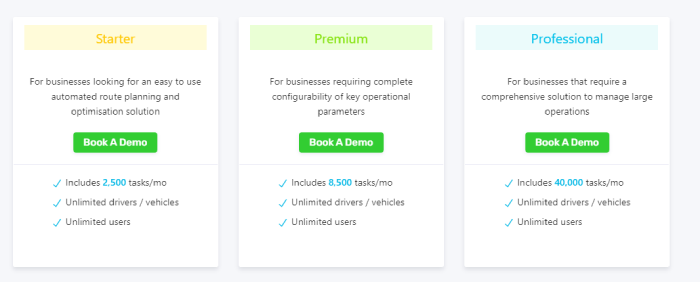
When choosing a plan make sure to notice the number of orders/deliveries/tasks that are included in each plan.
They represent the number of stops that you’ll be able to add to each route that you plan.
Going beyond this task limit may lead to an additional fee per task.
Providers can also set a limit on vehicles or software users, so make sure to check that as well.
When it comes to payment, most route planners are SaaS solutions (Software-as-a-Service).
Subscriptions are typically monthly (pay as you go) or annual.
Yearly contracts tend to be cheaper and have amenities like discounts or unlock extra features.
3. Optimization Speed
Route planning software doesn’t just plan routes. It can also optimize them.
When selecting a routing app, check the optimization speed.
Make sure to test it with the no. of routes you’re looking to plan per day.
And the parameters that you’ll use to optimize each route.
The best route optimization tools should be able to generate routes for 10,000 deliveries within a few minutes without lag or errors.
4. Integration
Integration is key if you want to achieve complete automation.
Almost every route planning software solution supports API integration.
This enables you to connect all your other apps to one centralized platform.
For example, our customers integrate eLogii with telematics systems, OMSs like Shopify and WooCommerce, CRMs, and other systems.
Make sure to ask what kind of support the software you end up choosing provides.
This ensures that you don’t end up with a document for a developer, without the developer to implement the code to your systems.
5. UI & UX
Finally, take notice of the user interface and experience of the software that you’re buying.
Here’s what eLogii’s UI looks like:
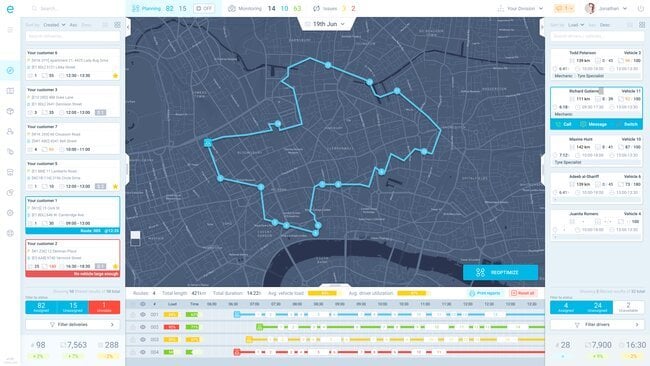
Make sure the platform you use is clean and easy to navigate.
Although it can be difficult for users to adjust at first, good UI and UX can cut the learning curve.
And make it easier for your staff to use it down the line.
(Especially if you have to plan and schedule 10,000 per day.)
To ensure your route planning software is running up to speed, it’s extremely important that you set aside some time to set it up the right way.
This can take a few hours to complete.
But the aim is to create a virtual model of your delivery as accurately as possible.
This will allow you to plan routes based on a number of factors that affect operational efficiency.
So more details = better route planning.
And although there’s a lot, it isn’t that difficult to do.
Here’s an example of how that works with eLogii:
Step #1: Log into your account - You can access eLogii using any popular browser that you have on your device (Chrome, Opera, Safari, Explorer, Edge, Mozilla, etc.).
Once on the site, visit the dashboard and log in to your account using your username and password.
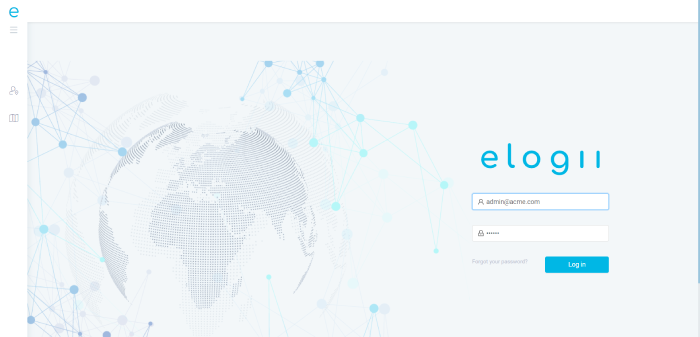
Step #2: Set up the platform environment - This involves replicating the environment within which your delivery operates.
That means adding essential data, like information about your company and the part of the world you’re operating in:
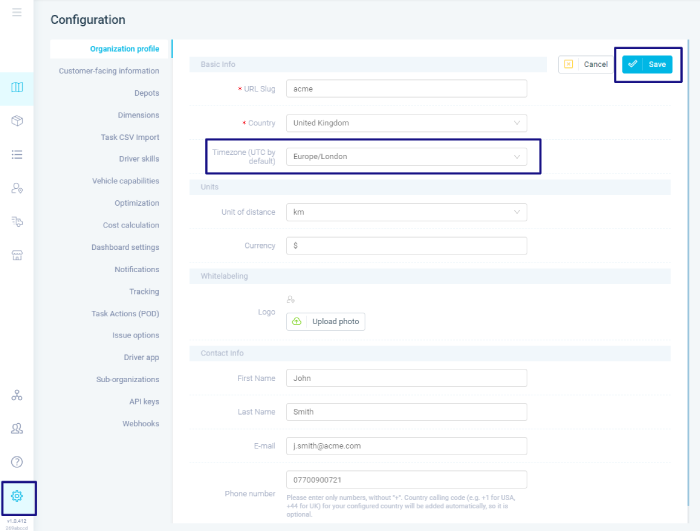
But also adding specific information about the dimensions that you’re using:
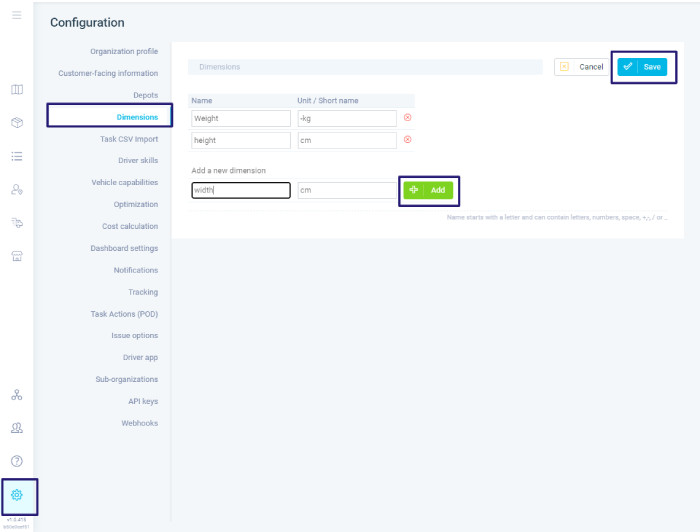
Step #3: Adding depot locations - Depots represent pick up locations. Warehouses, storage facilities, supply depots, physical stores, and other facilities where your drivers load vehicles and pick-up orders for delivery:
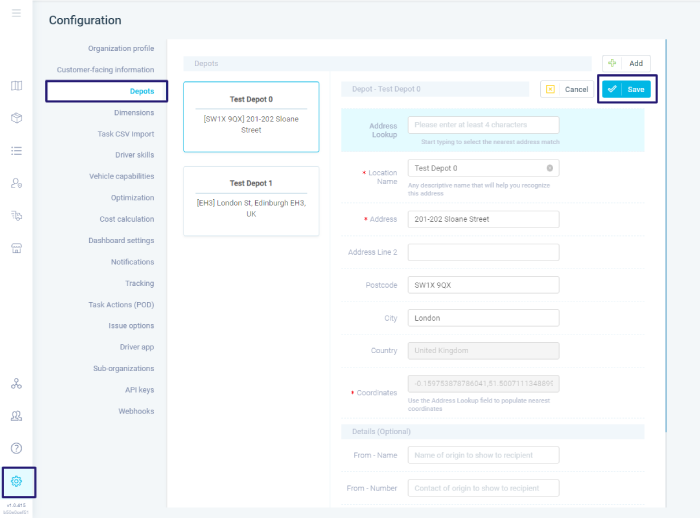
Step #4: Setting up vehicles - Once you have pick-up points sorted, you can start creating vehicle profiles:

This part is important because you can set up the weight and volume for each vehicle.
That helps the system later on to determine payload capacity. So that you can fill up each vehicle with orders as much as possible, without exceeding what is physically available.
Step #5: Create driver profiles - Same as with vehicles, it’s important to create profiles for your drivers:
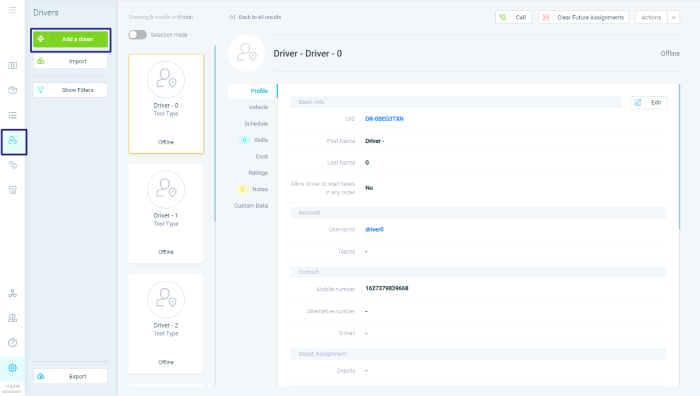
This helps the software to determine driver availability, so it can plan better delivery schedules around your routes.
This means adding work hours and breaks, the driver’s hourly rate, skills, but also connecting the platform to the driver’s app. Which is the next step.
Step #6: Install the driver app - Driver delivery apps are part of almost every route planning solution.

Their role is to enable the software to track the driver in real-time and dispatch route, schedule, and order information to the driver:
The app helps the driver to perform key activities in the field, such as collecting proof of delivery:
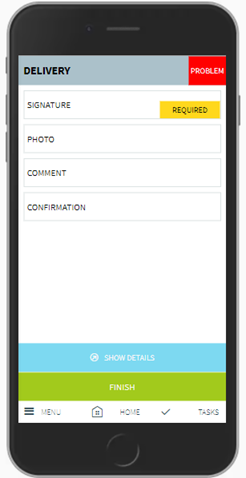
The app can also be integrated with Google Maps, HereMaps, and Waze to help the driver navigate from stop to stop.
Step #5: Configuring optimization parameters - This is where you set up the how you want the software to optimize the routes you plan:

You can set up how the software assigns tasks based on driver availability, vehicle capacity constraints, and traffic.
And how you want the software to calculate the estimated time of arrival for each delivery.
Once all of this is finished you can start planning routes and optimize them using the software.
Now that your route planning software is set up, it’s time to start planning your delivery routes.
Here’s exactly how you can do that with eLogii (even when you have to plan 10,000 deliveries per day):
1. First, you need to import delivery tasks to the software.
A task can either be an order pick-up or drop-off.
You can add tasks manually via the dashboard:
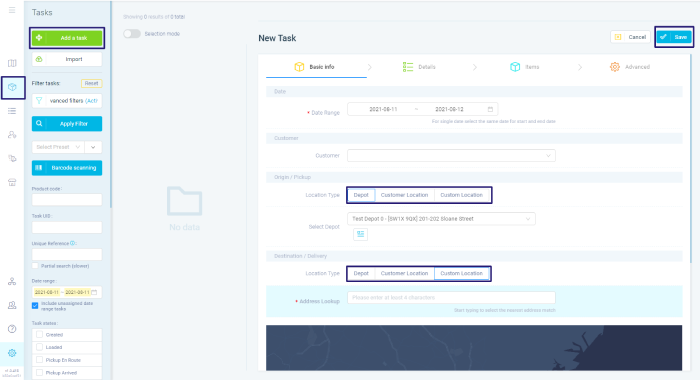
This isn’t route planning automation. But it is useful.
For example, when you want to add an incoming order at the last minute.
Or when you want to add delivery returns.
(Especially if the return destination is on an existing route.)
But true routing automation happens via:
Uploading and saving a .CSV file (spreadsheet) imports delivery requests to the dashboard and generates tasks within the software:
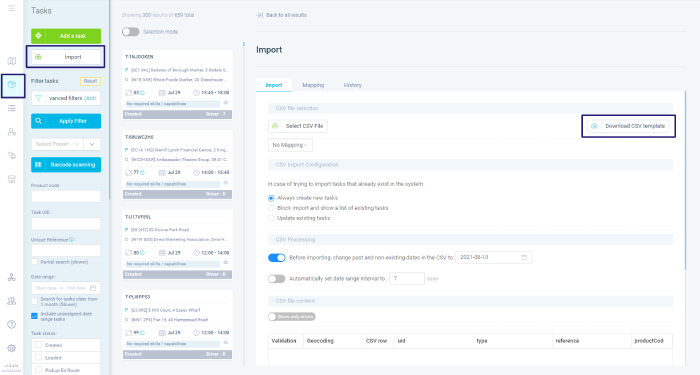
There is a prepared template that you can download from the dashboard.
You can use it to populate fields from your order management system (OMS).
Or set the OMS to generate the .CSV files for you based on the template.
Depending on the size of the file this may take a few minutes.
But virtually no limit to how many tasks you can upload.
The second option is to use APIs to integrate the route planning software with an OMS:
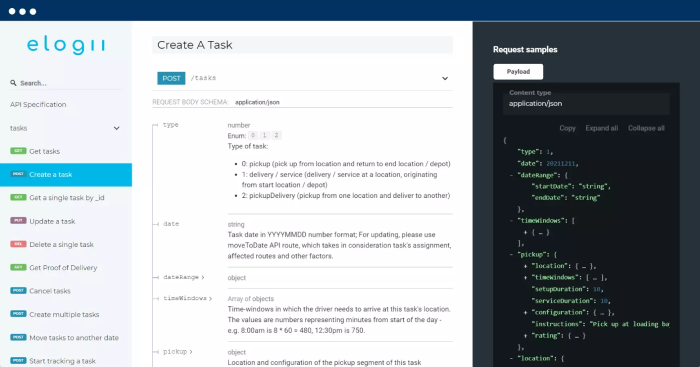
This connects the two systems and provides access in and out of both systems to live data, functions, and operations.
The software will then automatically generate tasks as soon as a customer places a delivery order at checkout on a sales platform.
And you can do this for all of your sales channels like your website, social media, ecommerce platform (Shopify, WooCommerce, Squarespace), etc.
Another benefit to this way of generating tasks is that you allow customers to select delivery dates and times.
When a task is generated, the software will automatically close that delivery slot and make it unavailable to other customers.
So delivery requests don’t overlap, for example. (Which is especially useful when you have to plan 10,000 orders per day.)
NOTE: For this you’ll need to deploy your tech team. Developers have to download the API documentation and contact our support team to set up access to in and out to the system’s functionality.
2. Second, you have to select the delivery date when you want to plan routes.
With eLogii this is pretty straightforward:
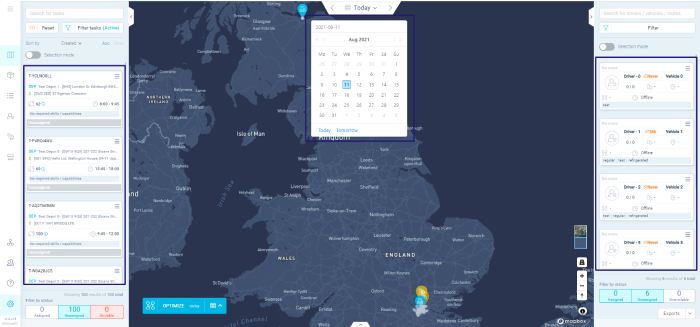
You can do this:
3. Finally, plan optimized routes.
This is HUGE.
Once you’ve set up everything, imported tasks, and selected the date, all you have to do is click the Optimize button to plan routes for all your drivers and delivery requests:

The software will generate routes automatically:

Depending on the number of tasks and the optimization parameters this can take a few minutes.
The stops on each route will be optimized for best performance and maximum efficiency.
For example, all of the routes will be optimized for maximum stop density:
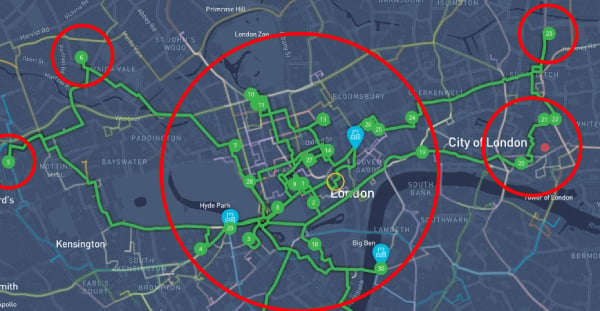
Or they can be circular, so drivers don’t have to travel the same distance twice:

Based on your configuration, the software will also avoid paths with high traffic congestion to raise delivery speed.
While at the same time, trying not to lower fuel consumption by reducing the distance between stops.
At any point you can manually adjust each route or assign specific tasks to different drivers.
And you can view the route timeline at the bottom of the screen:
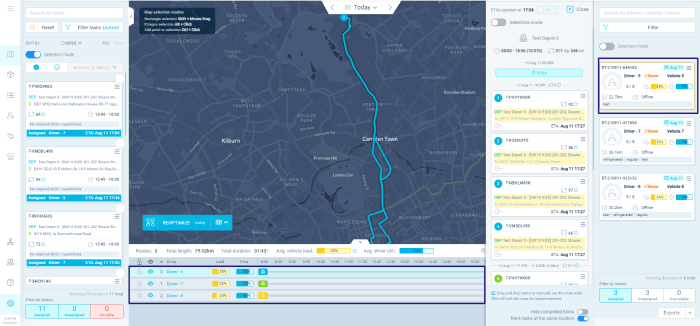
With the driver details on the right side of the screen that display payload capacity, route completion, ETA to next stop, delivery windows, etc.
Once you’re satisfied with all of the routes, you can lock them.
While the tasks and routes are automatically dispatched to all of your drivers.
Which the drivers can view and access over the Driver app on their phones:

Overall, we can draw a straight line from using eLogii to better route planning. But also higher performance and greater efficiency.
But don’t take our word for it.
Here’s a quick preview of some of the great reviews that we’ve been getting:
“Very responsive customer service team, fun product to implement. This product will save your drivers time, your dispatchers time, and lots of money in mileage.”
“eLogii has the ability to take pictures, enter notes, which again is great help when talking about damage claims.”
“It’s fresh. Warehouse and map are looking good.”
“eLogii is a time saver to have so many features in one place. It replaces 3 or 4 different tools, combined into one. This is a huge time saver on day-to-day operations.”
“The system is easy to use, and very effective for helping plan delivery of our goods using our fleet of trucks. An Electronic Proof Of Delivery (E-POD) helps eliminate questions and disputes.”
So we can say that, overall, eLogii has helped our customers improve how they manage operations.
Not only with route planning.
But with other features that make it SUPER easy to plan and organize their last mile.
Which, at least to our customers, makes eLogii worth using.
Learn how to plan deliveries in 2025. Discover what is delivery planning, its most effective elements, what tools to use, and the latest success...
Discover optimal delivery rates for subcontracting, independent contracting, and multi-stop deliveries to boost earnings effectively.
Struggling with late deliveries? Explore the causes & solutions to optimize your delivery process. Discover how eLogii Software can streamline...
Be the first to know when new articles are released. eLogii has a market-leading blog and resources centre designed specifically to help business across countless distribution and field-services sub sectors worldwide to succeed with actionable content and tips.
